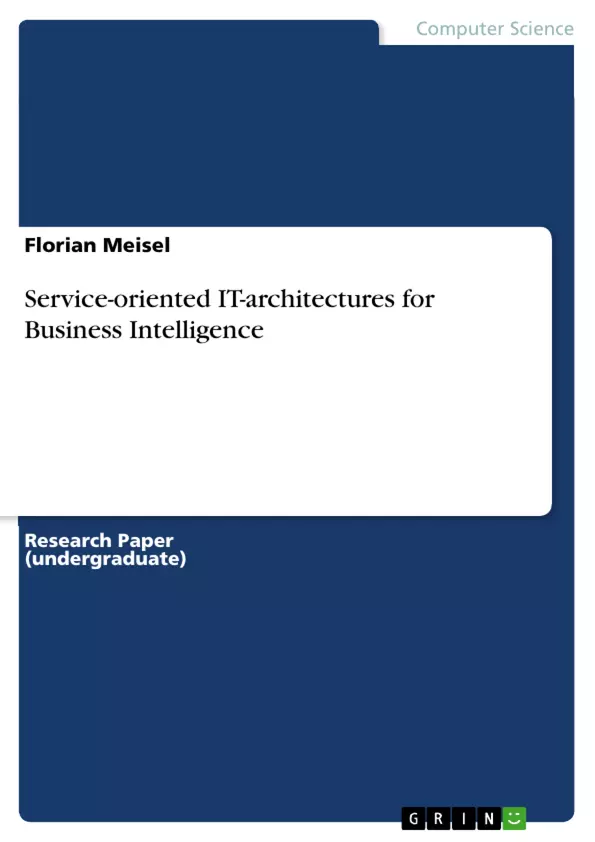Einstein made that famous statement many decades ago, and it's still relevant today for building superior software systems. Unfortunately, as anyone who has been in the IT industry for long can point out, far too many software systems have failed Einstein's test. Some are made too simple to carry out the duties they are supposed to perform. Others are made too complex, and the costs of building and maintaining them have rocketed, not to mention the nearly impossible tasks of integrating different systems together
Businesses nowadays operate in a fast changing and highly complex environment, with more competitors fighting for potential clients. This environment calls for businesses that have the ability to rapidly react on changes and thus are highly flexible in their nature. With the high amount of knowledge available to businesses it
becomes harder to identify changes in the market and make the correct decisions. This is where Business Intelligence comes into discussion which aims at supporting exactly this process of evaluating the data and knowledge available and making decisions. But knowledge is often stored in different locations throughout the
business, especially in international businesses with many different country offices the issue of different IT-applications used that can not communicate with each other appears to be a major problem. This creates a demand for service-oriented architecture.
Overt the last four decades IT systems have grown exponentially, leaving companies to handle increasingly complex service architectures. Traditional architectures have reached the limit of their capabilities, while traditional needs of IT organisations persist. IT departments still need to respond quickly to new business
requirements, continually reduce the cost of IT to the business and an integrate new business partners and customers.
In this paper I would like to take a closer look at the concept of service-oriented architecture and examine the role of it with regards to Business Intelligence.
At first I will introduce the topic of business intelligence, in the second part of the paper which is my main focus, I aim at providing deeper insight on service-oriented architecture. I will then concentrate on the question how this architecture is connected
to Business Intelligence, giving a case study of Deutsche Post as example.
Inhaltsverzeichnis (Table of Contents)
- 1. Introduction
- 2. Business Intelligence – Definitions and Tasks
- 2.1 The Value of Business Intelligence
- 2.2 The Business Intelligence Process
- 3. Service Oriented Architecture (SOA)
- 3.1 What is understood by a SOA?
- 3.2 Requirements for a SOA
- 3.3 Characteristics of a SOA
- 3.3.1 The SOA Temple
- 3.4 Definition of „Service“ for SOA
- 4. SOA for Business Intelligence
- 4.1 Three Process Phases of BI with SOA
- 4.2 Benefits of SOA for Business Intelligence Tasks
- 4.3 What the Transformation Opportunity Looks Like
- 5. Case Study: Implementation of a Service Oriented Architecture at Deutsche Post Mail
- 6. Conclusion
- 7. References
Zielsetzung und Themenschwerpunkte (Objectives and Key Themes)
This paper examines the concept of service-oriented architecture (SOA) and its role in enhancing Business Intelligence processes. It aims to provide a comprehensive understanding of SOA and its applications within the context of Business Intelligence. The paper explores the value of Business Intelligence, the process of utilizing data for decision-making, and the benefits of integrating SOA into the BI process. Key themes include:- The importance of flexibility and agility in today's rapidly changing business environment
- The challenges and opportunities of integrating diverse data sources in complex organizations
- The concept of SOA and its characteristics
- The benefits of SOA for Business Intelligence tasks, including improved data accessibility, increased efficiency, and enhanced decision-making
- The implementation of SOA in a real-world case study, showcasing its practical applications
Zusammenfassung der Kapitel (Chapter Summaries)
The paper begins by introducing the concept of Business Intelligence (BI) and its significance in today's competitive environment. It highlights the challenges of integrating various data sources and the need for robust decision-making tools. The chapter then delves into the concept of SOA, defining its characteristics and exploring its potential as a solution for managing complex IT infrastructures. The subsequent chapters delve into the application of SOA specifically for Business Intelligence. The author outlines the key benefits of integrating SOA into the BI process, including enhanced data accessibility, increased efficiency, and improved decision-making capabilities. The paper concludes by presenting a case study of the implementation of SOA at Deutsche Post Mail, illustrating the practical applications of the technology in a real-world scenario.Schlüsselwörter (Keywords)
The primary focus of the paper is on service-oriented architectures (SOA) and their application for Business Intelligence. Key concepts explored include the value of Business Intelligence, the need for flexibility and agility in business operations, the integration of disparate data sources, the characteristics of SOA, and the benefits of SOA for Business Intelligence tasks. This paper highlights the transformative potential of SOA in enhancing decision-making processes within organizations.- Quote paper
- Mag.Bakk Florian Meisel (Author), 2006, Service-oriented IT-architectures for Business Intelligence, Munich, GRIN Verlag, https://www.grin.com/document/115334



